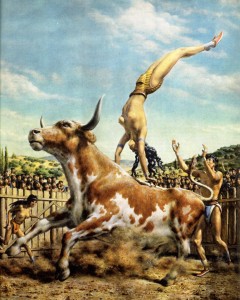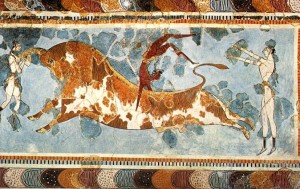So far, so good – two weeks into 2018 and I’m maintaining my resolution to keep a weekly blog. Yay!
The week’s writing has gone well. I’ve surpassed my target for word count and I’m reasonably happy with the quality of what I’ve written. I usually tend to feel a little disappointed with it – probably creative paranoia – so I consider that an improvement. Also on the writing fun, The Gates of Troy is being promoted through Bookbub this week, so the e-book is available for just 99p.
I’ve been doing a bit of research about the ancient art of Minoan bull leaping this week. Twenty or so years ago, when I was younger and more reckless, I took part in the Running of the Bulls at Pamplona. I was caught in the midriff by a charging bull and tossed up like a pancake, performing a couple of mid-air somersaults before landing shoulder-first and breaking my collarbone. I was put in an ambulance with an American boy of around ten, whose dad had taken him into the Running. They were separated and the boy got trampled. He was later told by a medic that he had probably broken his back. He was taking it all very calmly, considering he was thousands of miles away from home, with no parents, no money, and facing the prospect of life in a wheelchair. I never did find out what happened to him.
Ever since then I’ve been a bit wary of large horned animals, though I have to admire the courage of these Minoan bull-leapers. There are a handful of famous frescoes and figurines from digs at Knossos that depict people apparently leaping over charging bulls. It’s a practice that’s still carried on in parts of Spain and Greece today, though the bulls used are considerably smaller than the giant cross-bred aurochs that the ancients performed with (now extinct).
One famous fresco appears to show two women – usually depicted with pale skin, otherwise you’d take them for men – either side of a bull, with a deeply tanned man leaping over its back. Whether this was a sport or part of a religious ritual is much debated. The fresco seems to depict one bull-leaper grabbing the animal’s horns to lever herself up, while another springs from its back, though it’s doubtful whether they actually made contact. Several modern leapers have tried this and died in the attempt.
Despite writing full-time now, I do spend half a day volunteering at my youngest daughter’s primary school. Usually I read one-to-one with Year 1s and Year 4s, but this week I was asked to help the Foundation kids (aged 4 and 5) to write stories. As they’re still learning to write individual letters, I wasn’t expecting great things. However, I was very pleased with one little girl who had written the following about Olaf from the Disney film, Frozen: “I am Olaf and I like warm hugs”. Sweet!
Nothing very exciting happened during the week. I had a pint with a few chums at my local on Monday (a regular slot), and last night visited an old friend in Leicester who is kindly upgrading my computer for me. This morning, I had a cooked breakfast at the local delicatessen/bakery/restaurant I go to every Friday, and this evening I went for a curry at a restaurant around the corner from where I live. Great food, but took forever to get the bill.
I haven’t watched many films this week. I managed to finish Guardians of the Galaxy 2, which, overall, I enjoyed. If you can tolerate the usual Hollywood love of things being blown up and characters-escaping-from-situations-that-jar-you-out-of-your-suspension-of-disbelief, then you should find it’s visually pleasing and very funny in places. Inspired by the little girl from Foundation, I also watched Frozen. And she’s right – Olaf does like warm hugs. And I like the songs in that film.
As mentioned last week, I’ve abandoned reading fiction for the time being to focus on research. I’m now about half way through Band of Brigands and am learning lots of useful tidbits about First World War tanks for my next writing project. It’s usually the few small details, rather than too many details, that are most effective in transporting a reader to another point in history. Though it’s often tempting to saturate a scene with all the fascinating facts learned during the research phase, a writer must never forget they are writing fiction, not a history textbook.
I’ve also bought 1918: The Last Act, by Barrie Pitt (I find the last year of the Great War its most interesting), and Troop Leader by Bill Bellamy, a first-hand account from World War Two that I leafed through in the bookshop and couldn’t put down. Finally, I had a glance at Sniping in France by Captain V Hesketh-Prichard, another book that I had a flick through and have been unable to put down since. It’s well written (Captain Hesketh-Prichard once wrote a series of books that gave Hollywood the inspiration for Zorro) and full of those invaluable bits of information you can only learn from someone who has been there – in his case, the Western Front from 1915 to 1918.
As for my ongoing attempt to read the Bible in two years, I’m now on King Solomon’s Song of Songs. The imagery is ancient, rural and quaint: “Your navel is a rounded goblet that never lacks blended wine. Your waist is a mound of wheat encircled by lilies. Your breasts are like two fawns, twins of a gazelle.” The Greeks of Homer’s time would have loved it.
Next week’s blog may be a day late, as I’m in London on Friday to meet my editor and discuss the first of the Heracles trilogy. Wish me luck!






